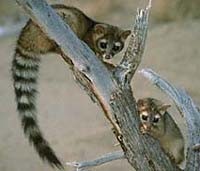Bassariscus
chi động vật có vú
Bassariscus là một chi động vật có vú trong họ Gấu mèo Bắc Mỹ, bộ Ăn thịt. Chi này được Coues miêu tả năm 1887.[2][3][4][5] Loài điển hình của chi này là Bassariscus astutus.
| Bassariscus | |
|---|---|

| |
| Phân loại khoa học | |
| Vực: | Eukaryota |
| Giới: | Animalia |
| Ngành: | Chordata |
| nhánh: | Mammaliaformes |
| Lớp: | Mammalia |
| Bộ: | Carnivora |
| Liên họ: | Musteloidea |
| Họ: | Procyonidae |
| Chi: | Bassariscus Coues, 1887 |
| Loài điển hình | |
| Bassaris astuta[1] (Lichtenstein 1830) | |
| Các loài | |
Các loài
sửa| Ảnh | Tên khoa học | Tên thông dụng | Phân bổ |
|---|---|---|---|
| Bassariscus astutus | Ringtail | Southern United States from southern Oregon and California throughout the southwestern states to Texas. In Mexico it ranges from the northern desert state of Baja California to Oaxaca. Its distribution overlaps that of B. sumichrasti in the Mexican states of Guerrero, Oaxaca and Veracruz.[6] | |
| † Bassariscus casei[7] | Case's ringtail[8] | An extinct species with fossils first found in the Upper Pliocene strata of the Rexroad formation in Kansas[9] and later in the Late Blancan strata in California.[8] | |
| † Bassariscus sonoitensis[7] | An extinct species with only three known locations in Papago Springs Cave, Santa Cruz County, Arizona (1942), San Josecito Cave, Nuevo León, Mexico (1958), and U-Bar Cave, Hidalgo County, New Mexico (1987), that lived from the late Pleistocene and went extinct before the full-glacial period of the late Wisconsinian.[10] | ||
| Bassariscus sumichrasti | Cacomistle | Central America, from south central Mexico to Panama. |
Hình ảnh
sửaChú thích
sửa- ^ Wilson, D. E.; Reeder, D. M. biên tập (2005). “Genus Bassariscus”. Mammal Species of the World . Baltimore: Nhà in Đại học Johns Hopkins, 2 tập (2.142 trang). ISBN 978-0-8018-8221-0. OCLC 62265494.
- ^ Lỗi chú thích: Thẻ
<ref>sai; không có nội dung trong thẻ ref có tênmsw3 - ^ K.-P. Koepfli; M. E. Gompper; E. Eizirik; C.-C. Ho; L. Linden; J. E. Maldonado; R. K. Wayne (2007). “Phylogeny of the Procyonidae (Mammalia: Carvnivora): Molecules, morphology and the Great American Interchange”. Molecular Phylogenetics and Evolution. 43 (3): 1076–1095. CiteSeerX 10.1.1.495.2618. doi:10.1016/j.ympev.2006.10.003. PMID 17174109.
- ^ Eizirik, E.; Murphy, W. J.; Koepfli, K.-P.; Johnson, W. E.; Dragoo, J. W.; Wayne, R. K.; O’Brien, S. J. (4 tháng 2 năm 2010). “Pattern and timing of diversification of the mammalian order Carnivora inferred from multiple nuclear gene sequences”. Molecular Phylogenetics and Evolution. 56 (1): 49–63. doi:10.1016/j.ympev.2010.01.033. PMC 7034395. PMID 20138220.
- ^ Helgen, K. M.; Pinto, M.; Kays, R.; Helgen, L.; Tsuchiya, M.; Quinn, A.; Wilson, D.; Maldonado, J. (15 tháng 8 năm 2013). “Taxonomic revision of the olingos (Bassaricyon), with description of a new species, the Olinguito”. ZooKeys (324): 1–83. doi:10.3897/zookeys.324.5827. PMC 3760134. PMID 24003317.
- ^ Reid, F.; Schipper, J.; Timm, R. (2016). “Bassariscus astutus”. Sách đỏ IUCN về các loài bị đe dọa. 2016: e.T41680A45215881. doi:10.2305/IUCN.UK.2016-1.RLTS.T41680A45215881.en. Truy cập ngày 13 tháng 11 năm 2021.
- ^ a b “Volume Issue 327 | Mammalian Species | Oxford Academic”. 25 tháng 5 năm 2017. Bản gốc lưu trữ ngày 25 tháng 5 năm 2017. Truy cập ngày 20 tháng 4 năm 2021.
- ^ a b “Procyonidae - Raccoons and Ringtails | University of Texas El Paso”.
- ^ Hibbard, C. W. (tháng 8 năm 1952). “A new Bassariscus from the Upper Pliocene of Kansas|Journal of Mammalogy”. 33 (3): 379–381. doi:10.2307/1375775. JSTOR 1375775. Chú thích journal cần
|journal=(trợ giúp) - ^ Harris, A. H. (tháng 10 năm 1990). “Taxonomic Status of the Pleistocene Ringtail Bassariscus sonoitensis (Carnivora)|The Southwestern Naturalist”. 35 (3): 343–346. doi:10.2307/3671953. JSTOR 3671953. Chú thích journal cần
|journal=(trợ giúp)
Tham khảo
sửa